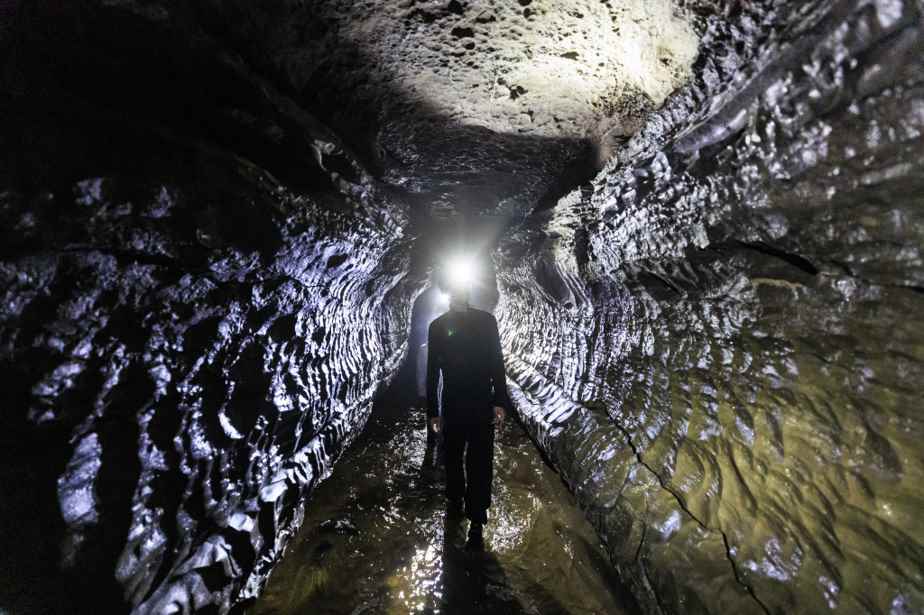In the Portneuf regional natural park, there is a specific place, on the trail, where you can hear a kind of very dull echo if you jump a little. There is another universe below, a mysterious cave. This is Saint-Casimir’s Devil’s Hole.
Posted at 11:30 a.m.
It can be explored with a guide, choosing between a tourist route and a more adventurous one. The first is reputed to be easy, but make no mistake, it’s more than just a walk. Expect to walk in mid-calf water for the entire 90-minute tour.
For the adventure course, we are promised crawling and crawling in water and mud, in long cramped galleries. Owl ! This is the option we choose.
Portneuf Regional Park provides helmets and headlamps and recommends wearing shoes and clothing that can get wet and dirty. For the adventure course, he suggests knee pads. It’s a very good idea.
-

PHOTO EDOUARD PLANTE-FRÉCHETTE, THE PRESS
Étienne Pelletier and his son Bastien have decided to venture underground for a morning.
-

PHOTO EDOUARD PLANTE-FRÉCHETTE, THE PRESS
The guide, Antonin Marchand, shows Bastien and Étienne Pelletier where the cave ends at the Sainte-Anne River.
-

PHOTO EDOUARD PLANTE-FRÉCHETTE, THE PRESS
The young Bastien Pelletier enters the cave.
-

PHOTO EDOUARD PLANTE-FRÉCHETTE, THE PRESS
Étienne Pelletier emerges from a rather aquatic gallery.
1/4
Our guide, Antonin Marchand, does not hide his enthusiasm before the visit: a young local, he has often visited the cave as part of holiday camps. For a long time, he had dreamed of being a guide there, but he had to wait until he was old enough. This year, at 16, he can finally put on the caving guide suit.
He explains the formation of the Trou du diable, in length, the second accessible cave in Quebec, with its 980 m. It was carved out of limestone by a small tributary of the Sainte-Anne River.
The Cave of Challenges
We take a small path in the forest to get to where the stream sinks into the earth, which is called the loss. This is where the little expedition begins, where you have to turn on the headlamp. You have to go down between a few blocks to reach the main gallery, high, quite wide, accessible to participants of both routes.
Under twenty centimeters of water, the ground is perfectly flat, rather sandy. Looks like the cave was created specifically for tours. We move forward at a good pace, perceiving, between the splashes of our steps, the sound of water percolating through the rock.
-

PHOTO EDOUARD PLANTE-FRÉCHETTE, THE PRESS
Back to the main gallery
-

PHOTO EDOUARD PLANTE-FRÉCHETTE, THE PRESS
The father-son duo, Étienne and Bastien Pelletier, enter a cramped gallery.
-

PHOTO EDOUARD PLANTE-FRÉCHETTE, THE PRESS
It’s narrow but it’s ok.
-

PHOTO EDOUARD PLANTE-FRÉCHETTE, THE PRESS
Back to the open air
1/4
Antonin shows us here stalactites in the making. There, we find small abandoned cones, hidden by a squirrel who had not expected that the frost would block access to his pantry in winter. Further, spiders Meta ovalis who spend their lives underground. Fortunately, no one is arachnophobic in the small group.
Then it’s THE test. A tiny gallery located in height is detached from the main gallery to join it a few meters later.
The challenge is to climb to reach this gallery, crawl under its extremely low ceiling and fall further back into the main gallery.
This passage is called the Template. For the guide, it’s a good way to see if participants can get started in the “adventure” section of the cave.
Antonin recounts how some people, who had probably misread the description of the adventure course, suddenly remembered that they did not like water or cramped spaces and preferred to stay on the tourist course. The members of our small group, starting with Bastien Pelletier, 8, passed the test without any problem.
Two other challenges of the kind follow to prepare well for the adventure part, the famous Jean-Lamarre gallery, which we can finally borrow. The passage is narrow, the ceiling is low, but above all, the small corridor is partly flooded. You have to crawl a bit in the mud, but more often than not it involves walking on all fours in water that can go up to your neck.
This is where knee pads are particularly popular. In fact, it’s quite fun to pretend to be a real speleologist and explore a world that we often ignore the existence.
Casually, the corridor brings us back to the main gallery. It’s still fun to get back on your feet. The small group resumes this large gallery to return to the starting point. But there’s no question of taking it easy: you turn off the headlamps to fall back into total darkness, letting your hand follow one of the walls to guide you. A glow appears, ghostly: it comes from a hole, high in the ceiling, which allows a glimpse of the outside world.
Another few tens of meters and the members of the small group emerge from the depths, wet, covered in mud, but very happy.
“It was really cool,” summarizes Bastien Pelletier.

